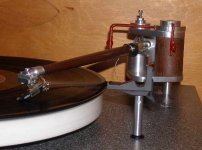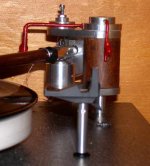Ron, it looks great! I can see a lot of care went into the construction of the arm. Glad it is working properly, hard work, but worth all the effort. 😀
Ron,
Beautiful arm. Way to hang in there. And on a Rek-O-Kut, too. I'd guess that's a real great combination.
And to the others who have posted their arms recently - beautiful work, all of you.
Beautiful arm. Way to hang in there. And on a Rek-O-Kut, too. I'd guess that's a real great combination.
And to the others who have posted their arms recently - beautiful work, all of you.
Congrats Ron!!!
Persistence pays in the end 🙂
Enjoy.
It IS an accomplisment indeed. Now you really understand why Frank prices his products as he does. You understand the justification. You understand what goes into producing the arm.
Welcome to the club 🙂 You've earned your merit badges!
Now it's you duty to help others along the path!
Praise Frank
JD
Persistence pays in the end 🙂
Enjoy.
It IS an accomplisment indeed. Now you really understand why Frank prices his products as he does. You understand the justification. You understand what goes into producing the arm.
Welcome to the club 🙂 You've earned your merit badges!
Now it's you duty to help others along the path!
Praise Frank
JD
My Schroeder clone is 99% complete. Need to replace two screws with grub screws, File out the cart mount slots, install tonearm wire and cartridge. Then it is off to the turntable!! Please leave comments/suggestions!! Happy listening!! Ernst
Dude .... Beautiful work ...

Congrats Ron!!!
Persistence pays in the end 🙂
Enjoy.
It IS an accomplisment indeed. Now you really understand why Frank prices his products as he does. You understand the justification. You understand what goes into producing the arm.
Welcome to the club 🙂 You've earned your merit badges!
Now it's you duty to help others along the path!
Praise Frank
JD
JD,
I've made so many mistakes along the way, I should be able to help many people "along the path"! LOL 😀
Praise and Gratitude to Frank!
I can hardly wait until my Denon DL110 has "come of age" and softened up some. It sounds terrific now, should be excellent later. I do need to someday get my idler wheel resurfaced though. I can think of a couple of places that do it.
Ron
Just checking in and bumping this old thread to see if anyone else has jumped on board. It's been a while guys. How y'all are doing?
JD
JD
Collecting parts for my Schroeder build.
Will use carbon fibre arm (from carbon fibre arrows) and strong button like magnets.
Will use carbon fibre arm (from carbon fibre arrows) and strong button like magnets.
How y'all are doing?
JD
Wait for tomorrow's race in Monaco!
Regards zeoN_Rider
NICO!!!!!
His Papa would have been proud! Good to see the Silver Arrow back on top!
Tho I'm an Alonso / Ferrari fan, I was happy to see Nico at the top of the podium. He's a class act. ... man does Perez have a set or what!?.
JD
His Papa would have been proud! Good to see the Silver Arrow back on top!
Tho I'm an Alonso / Ferrari fan, I was happy to see Nico at the top of the podium. He's a class act. ... man does Perez have a set or what!?.
JD
Wait for tomorrow's race in Monaco!
Regards zeoN_Rider
An experiment,
Hi All, Been enjoying my linear tracker a lot. It does have a problem that is non existent with my Schroeder clone. The Schroeder is virtually immune to skips and clicks. The LT seems to be rather sensitive to them. The activity in this thread inspired me to try a few things that have been stewing in the back of my mind for a while now. So I modified my Schroeder clone using some parts from earlier experiments. First I removed the single string suspension and used an inverted V string. The string goes straight through the arm just above the magnets on the center line of the wand and up into the adjusting screw. It also goes up through the hole that the single string exited the arm wand, ties to a nut (for now) and back down into the wand and out the opposite side hole. This is all pretty clear on the pics. I use a 16 pound test square cross section braided fishing line. Doesn't stretch at all. `The I removed the dome shape pole piece from the lower magnet and replaced the upper magnet with one about 1/16th of an inch larger in diameter than the lower magnet. This upper magnet has a hole in the center. The result is an assembly which is self centering to a very high degree and because of the 2 string suspension can not change azimuth at all.
Lastly I made a turret for mounting and adjusting anti-skate magnets, one on each side of the arm wand. A third magnet is mounted (black tape for now) to one side of the arm wand. The magnet on the right side of the arm pulls against the magnet mounted on the wand. The magnet on the other side provides repelling force. As the arm travels across the record, the skating force diminishes. So also does the magnetic attraction. As the arm gets closer to the repelling magnet its force builds up. By rotating the adjustable magnets further apart or closer as well as where on the center of the record this force field is positioned, it was very easy to achieve a uniform anti-skating force. The stylus would just sit there wherever on an uncut record I placed it. This arm design has been working like no other single string version I have built so far and is extremely stable. Soundwise this configuration is as near to what I get with the LT. I will comment more after using it for a bunch of months.
Time for sleep now.
G'nite,
BillG
Hi All, Been enjoying my linear tracker a lot. It does have a problem that is non existent with my Schroeder clone. The Schroeder is virtually immune to skips and clicks. The LT seems to be rather sensitive to them. The activity in this thread inspired me to try a few things that have been stewing in the back of my mind for a while now. So I modified my Schroeder clone using some parts from earlier experiments. First I removed the single string suspension and used an inverted V string. The string goes straight through the arm just above the magnets on the center line of the wand and up into the adjusting screw. It also goes up through the hole that the single string exited the arm wand, ties to a nut (for now) and back down into the wand and out the opposite side hole. This is all pretty clear on the pics. I use a 16 pound test square cross section braided fishing line. Doesn't stretch at all. `The I removed the dome shape pole piece from the lower magnet and replaced the upper magnet with one about 1/16th of an inch larger in diameter than the lower magnet. This upper magnet has a hole in the center. The result is an assembly which is self centering to a very high degree and because of the 2 string suspension can not change azimuth at all.
Lastly I made a turret for mounting and adjusting anti-skate magnets, one on each side of the arm wand. A third magnet is mounted (black tape for now) to one side of the arm wand. The magnet on the right side of the arm pulls against the magnet mounted on the wand. The magnet on the other side provides repelling force. As the arm travels across the record, the skating force diminishes. So also does the magnetic attraction. As the arm gets closer to the repelling magnet its force builds up. By rotating the adjustable magnets further apart or closer as well as where on the center of the record this force field is positioned, it was very easy to achieve a uniform anti-skating force. The stylus would just sit there wherever on an uncut record I placed it. This arm design has been working like no other single string version I have built so far and is extremely stable. Soundwise this configuration is as near to what I get with the LT. I will comment more after using it for a bunch of months.
Time for sleep now.
G'nite,
BillG
Attachments
Bill,
I can't figure out how you do this. How did you know I needed a magnetic anti-skate design?
I can't figure out how you do this. How did you know I needed a magnetic anti-skate design?
Bill,
I can't figure out how you do this. How did you know I needed a magnetic anti-skate design?
Hi Doug,
Good to hear from you again. How do I do it? It is easy. Unless you are building/using a LT design, everyone needs a magnetic anti-skate design. It is the only way I can see that a good anti-skate can be implemented which compensates for the changing skate force across the record and applies the anti force in the proper direction. Weights on strings apply a uniform force across the record. You can apply it in either direction though. Single magnets work but you may never get one to apply the force across the whole recorded disk. Tuning the strength and twist of Schroeder style suspensions will almost get you there if you have the stamina to find the right combination of threads and twists and apply them properly. That is where I bog down with that approach. The 2 magnets, one attracting and the other repelling does extend the force field to cover the entire record. If you don't have an uncut record, get or make one. I wasn't getting anywhere until I sanded an old record smooth. Thanks to Marekst for that one. Maybe some day I will try a Heim joint. But I go back to the original Well Tempered Arm with string suspensions, and I really like them for pivoted arms. Actually go back further than I'm old. I have a 400 day clock dating prior to 1900. It uses a single steel suspension spring (Pendelfeder) to hold and control a heavy lead pendulum disk that rotates back and forth and good luck.
Keep us informed of your progress.
BillG
Try using an EDM machine with a graphite electrode to drill the hole. Never drilled a magnet so I'm not sure what it would do to the magnetic properties...but have drilled .020 inch dia. holes in inconel and super tough stainless, titanium and tool steels. Would take about an hour to go in inch deep.
I'm new to this thread, so please be patient.
Has anybody done direct comparison with wood vs metal for the gallows main column?
I've probably got a wider variety of wood (exotic as well as English) than metal, and could probably make the whole thing out of wood.
Has anybody done direct comparison with wood vs metal for the gallows main column?
I've probably got a wider variety of wood (exotic as well as English) than metal, and could probably make the whole thing out of wood.
- Home
- Source & Line
- Analogue Source
- DIY Schroeder Tonearm?

